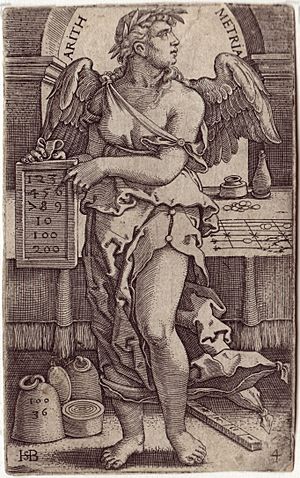Personification facts for kids
Personification is a cool way to describe things that aren't alive as if they were people. It's a type of figure of speech, which means it's a creative way to use language.
When you use personification, you give human qualities to objects or ideas. This includes things like emotions, wishes, sensations, gestures, and even speech. It often uses a metaphor, which is a way of comparing two unlike things without using "like" or "as."
You can find personification a lot in visual arts and writing. For example, if you say "the leaves waved in the wind," you're making the leaves sound like they have arms and can wave. Or, "the Sun smiled at us" makes the sun seem like a happy person. When "the wind shouted," it sounds like a loud person. In all these examples, things that aren't human are given human actions or feelings.
Sometimes, personification is used when animals or legendary creatures are given human traits. This is called anthropomorphism. It's common in stories and cartoons where animals talk or act like people.
Contents
What is Personification?
Personification is a literary tool that helps writers make their words more interesting. It makes non-living things or abstract ideas easier to imagine. By giving them human actions, thoughts, or feelings, they become more relatable.
How Personification Works
Personification works by connecting something non-human to human experiences. It helps readers or viewers understand a concept better. For example, "the old house groaned" makes you think of an old person complaining. It adds a deeper meaning to the description.
This technique is often used in poetry, storytelling, and even everyday conversations. It helps to create vivid images in your mind. It can also make a story more exciting or emotional.
Personification in Art and Writing
Personification has been used for a very long time in different forms of art. Artists and writers use it to bring ideas to life. It helps them show complex concepts in a simple way.
Examples in Literature
Many famous writers use personification to make their stories richer. For instance, in fables like those by Aesop, animals often talk and act like people. This helps to teach lessons in a fun way.
- "The wind whispered secrets through the trees." (Wind is given the human action of whispering.)
- "Time flies when you're having fun." (Time is given the human ability to fly.)
- "The alarm clock screamed at me to wake up." (An alarm clock is given a human voice.)
Personification in Visual Arts
In visual arts, personification can be seen in statues, paintings, and cartoons. Artists might draw a country as a person, like Uncle Sam for the United States. Or they might show ideas like "Justice" as a blindfolded woman holding scales.
These visual examples help people quickly understand what the artist wants to show. It makes abstract ideas more concrete and easier to grasp.
Related Topics
- Anthropomorphism: Giving human traits to animals or gods.
- Death (personification): The idea of death as a character, like the Grim Reaper.
- Helios: The ancient Greek god who personified the Sun.
Images for kids
-
These porcelain figures from around 1775 show the four continents as people. From left to right: Asia, Europe, Africa, and America.
-
Jean Goujon's artwork, The Four Seasons, shows the seasons as human figures. These are reliefs on the Hôtel Carnavalet in Paris, made around the 1550s.
-
These early modern statues in Vienna show Constance and Fortitude (strength) as people. They use classical iconography.
-
This old English picture from the 15th century shows the "Queen of Fortune" turning her wheel. Other personifications help her.
-
This detailed picture from the early 16th century shows two triumphal cars. They carry Chastity and Love, shown as people, from Petrarch's Triomphi.
-
These sculptures in Brno show Trade as a male figure and Tolerance as a female figure.
-
This cartoon from Punch in 1904 shows John Bull (representing Britain) walking away with Marianne (representing France). They turn their backs on the Kaiser (representing Germany).
See also
 In Spanish: Personificación para niños
In Spanish: Personificación para niños










